Note: the following has been edited since it was first posted in August, in order to allow for ‘right of reply’ from Incommunities. Social media notifications about the blog were not circulated until early September, after edits completed.
This last Friday, August 11th, we had the opportunity of a very interesting and informative meeting at the Shipley headquarters of Incommunities – Bradford’s main social housing provider. Their building sits right next to the Leeds-Liverpool Canal, as indeed do the three tower blocks of the Crosley Wood estate, Bingley, which we were there to discuss.
“We” were myself (Steve Bottoms), Paul Barrett (community development director at Shipley’s Kirkgate Centre), and Jenni M. – a resident at Crosley Wood who is the subject of our short film High Rise Damp, and of a blog post I wrote more recently, following the Grenfell tower disaster in London.
This meeting with the Chief Executive of Incommunities, Geraldine Howley, OBE, came about after I wrote to her – and to various members of the housing association’s board – with DVD copies of the film and a link to the blog. I am very grateful to Geraldine, and to her colleague Adrienne Reid (Assistant Chief Executive for Neighbourhood Services) for taking the time to speak with us, in the interests of building dialogue and understanding. Indeed, we were given considerably more than the hour initially timetabled, which was much appreciated.
I will confess to some disappointment on discovering that Geraldine (I hope it’s OK to use first names) had not actually watched our 15-minute film. That is, of course, perfectly reasonable, insofar that Chief Executives of large organisations are extremely busy people, who often need to work from summaries rather than first-hand sources. My disappointment lies simply in the fact that, while Geraldine had clearly been briefed on Jenni’s case (and had a number of documents about it in front of her), she had not taken the opportunity to consider Jenni’s story from her own point of view – as a tenant, as a parent, and as a citizen. That story is, I think, indicative of many people’s experiences, and it’s a perspective we don’t often hear. We had hoped that it might be heard at Incommunities.
That point aside, the meeting was productive and informative. I’m going to try to summarise what was discussed in three, inter-linked posts. This first one (below) looks specifically at the fire safety questions that have arisen for tower blocks, post-Grenfell.
Part 2 then takes a wider perspective on the architectural problems with “brutalist” concrete towers such as those at Crosley Wood, and indeed at the burden of costs that they impose on social tenants (we were alarmed to learn that these can be higher than in the private rented sector!).
Part 3 then looks at questions of shared responsibility — and the extent to which Incommunities can be seen to be working with social tenants to improve their living conditions (or not). Some significant terminology used by Incommunities, such as “customers” and “resilience”, also comes under examination.
Part 1. Fire safety
As noted above, our film with Jenni was not discussed at the meeting. However, it became clear that my previous blog post had caused some concern at Incommunities, not least because of my use of a photo of the burning Grenfell tower at the start of the blog, underneath the title “Life in a Bradford tower block”. (I promised to look at this again, but on reflection I’m going to leave it as is: I think it’s clear from the first paragraph that the image is of the London fire: there is no suggestion that one had taken place in Bradford.) There was also mention of inaccuracies in the blog, which I have promised to amend if they are pointed out to me. I am concerned to be as accurate as possible.
One important correction that was discussed during the meeting was the suggestion at the end of my blog (based on comments from Jenni), that the central fire alarm system in the Crosley Wood flats was disabled a few years ago — leaving residents to rely upon individual smoke alarms, and their own judgement about whether to call the fire brigade, rather than on any centralised response. However, Adrienne stressed that the central alarm system is, in fact, still operable. If it’s triggered, an autodialler calls Bradford Council’s Britannia House (Customer Services Centre), notifying them to call the Fire Brigade. Meanwhile, vents are automatically opened at the top of the buildings to help release smoke. It is only the sounders in the blocks themselves (e.g. the red bell in the picture below) that have been silenced, in order to avoid alarming residents into rushing for the stairwells…
This is in line with of the current Stay Put Policy for tower block fires, as agreed with West Yorkshire Fire and Rescue Service. The idea is that it is generally safer for residents to stay put in their flats during a fire than to be seeking to escape down the single, narrow stairwells that exist in blocks like those at Crosley Wood — just as firemen might be seeking to come up. The rationale here is that these flats are all designed as self-contained concrete boxes (concrete walls, ceilings, floors). Concrete is of course fireproof, so provided that doors are kept properly closed, it’s reckoned that it should be a good hour before a fire can escape from the flat it starts in. Within that hour, the Stay Put Policy assumes, the fire service should have been able to respond and extinguish the fire.
This all makes a lot of sense, if other factors are properly taken into account. The reason that this policy did not work at Grenfell tower was allegedly (there is a formal enquiry looking into this) that the flammability of the exterior insulation cladding on that building had not been taken into account (there’s more on insulation in Part 2 of this blog). Incommunities checked very swiftly, post-Grenfell, that their Bradford blocks do not use the same cladding that had cost so many lives in London.
That does not mean, of course, that the buildings are therefore definitively safe. It’s worth asking, for example, how water can leak so easily between floors (as Jenni vividly describes in our film) if these are sealed concrete boxes? But the good news is that Incommunities have now commissioned fully independent fire safety assessors (from Savills) to conduct a review of all their properties. This process starts later this week — from August 18th. This is a major undertaking, given that Incommunities has over 1200 flats in 30 tower blocks around the city.
During our meeting, it was suggested that this independent assessment would be conducted on a block-by-block basis. This concerned us somewhat, since our own (admittedly cursory) examination of two different, neighbouring flats at Crosley Wood, accompanied by an off-duty fire officer, indicated that there may also be fire safety issues on a flat by flat basis. Harry Whittle – from the Incommunities Asset Management staff – has since clarified via email that “in fact individual flats will be surveyed”.
Commenting on an earlier draft of this blog, Mr. Whittle also comments that problems with individual flats of the sort mentioned below should normally be addressed through “reporting of repairs by the customer”. However, as discussed in Part 3, such reporting by tenants has not always been responded to in a timely fashion by Incommunities. And poor responsiveness can lead to a resigned, “why bother?” attitude among some. This is one example of the way that shared responsibility needs to be revisited and reassessed on all sides.
Some examples of specific problems we looked at in our limited sample of two flats were:
… this kitchen door, which is as closed in the picture on the left as it ever gets: it simply doesn’t fit the door-frame. As such, it compromises the principle that a kitchen (the most likely place for a fire to start) can be left to burn for around 20 minutes before it spreads to other parts of the flat (and beyond the flat after 60 minutes). The tenant in question states that, in the twenty years she has lived in this flat, this door has never shut properly.
The same tenant does have a proper closing device on the front door of the flat… another important fire safety measure (below).
… but contrast that with the next picture, showing the inside of her neighbours’ front door. This one has no such closing device, and they don’t recall there ever being one in the 12 years they’ve lived there. Harry Whittle, however, notes that “when checking smoke alarms the engineers are checking front entrance door closers”, so it looks like this is an issue which will be directly addressed in the near future.
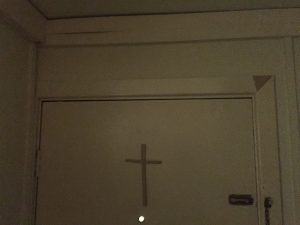 Notice in these pictures, also, the trunking adjacent to the ceiling, carrying various pieces of wiring. Because these flats have concrete ceilings and floors, wiring can’t be hidden within the walls as it would be in most homes, so has to be carried externally. That’s fine, from a safety point of view, if the trunking is metal (i.e. fireproof), but our fire officer pointed out several places in these flats where plastic trunking had been retrofit… as in the image below (where another wire has been casually taped to the trunking).
Notice in these pictures, also, the trunking adjacent to the ceiling, carrying various pieces of wiring. Because these flats have concrete ceilings and floors, wiring can’t be hidden within the walls as it would be in most homes, so has to be carried externally. That’s fine, from a safety point of view, if the trunking is metal (i.e. fireproof), but our fire officer pointed out several places in these flats where plastic trunking had been retrofit… as in the image below (where another wire has been casually taped to the trunking).
 Apparently, such plastic trunking has proven very dangerous in fire situations, because it melts quickly in the heat, leaving wiring hanging down as a trip hazard for residents and firemen alike. Harry Whittle’s email response on this point notes that, “per IEE 17th edition regs 2015, plastic trunking can still be used.” If you check these regulations online, though, it’s clear that they have been introduced because several firefighters have lost their lives in recent years as a result of hanging wires. The regs specify that where “non-metallic trunking” is in use, “a suitable fire-resistant means of support/retention must be provided to prevent cables falling out in the event of fire” (my emphasis). In the picture above, there does not appear to be any such additional, metallic support… and indeed the plastic stuff is actively peeling off the wall at the corners (see “sounder” image, further above). Clearly this is an issue that will need to be looked at.
Apparently, such plastic trunking has proven very dangerous in fire situations, because it melts quickly in the heat, leaving wiring hanging down as a trip hazard for residents and firemen alike. Harry Whittle’s email response on this point notes that, “per IEE 17th edition regs 2015, plastic trunking can still be used.” If you check these regulations online, though, it’s clear that they have been introduced because several firefighters have lost their lives in recent years as a result of hanging wires. The regs specify that where “non-metallic trunking” is in use, “a suitable fire-resistant means of support/retention must be provided to prevent cables falling out in the event of fire” (my emphasis). In the picture above, there does not appear to be any such additional, metallic support… and indeed the plastic stuff is actively peeling off the wall at the corners (see “sounder” image, further above). Clearly this is an issue that will need to be looked at.
 Our off-duty fireman also raised some concerns about this sort of metallic trunking, which carries wiring out of flats into the corridor to connect with the mains trunk to the left. Here, wiring has clearly been taken through the concrete wall, and our fireman speculated whether this might compromise the integrity of the flat’s “concrete box”. Harry Whittle’s response: “fire stopping works i.e. collars; intumescent putty are used to maintain this. However, again this is part of the Type 4 destructive survey.” This is the most rigorous type of fire risk assessment, apparently due to be carried out by Savills as part of the commissioned inspections.
Our off-duty fireman also raised some concerns about this sort of metallic trunking, which carries wiring out of flats into the corridor to connect with the mains trunk to the left. Here, wiring has clearly been taken through the concrete wall, and our fireman speculated whether this might compromise the integrity of the flat’s “concrete box”. Harry Whittle’s response: “fire stopping works i.e. collars; intumescent putty are used to maintain this. However, again this is part of the Type 4 destructive survey.” This is the most rigorous type of fire risk assessment, apparently due to be carried out by Savills as part of the commissioned inspections.
So it does sound like a very thorough assessment is being undertaken – and that should be reassuring for residents. Before moving on, though, I want to gently query the disabling of the alarm sounders, as previously mentioned. Because while this makes good sense from an operational/managerial point of view (i.e. maximising the likelihood that people will “stay put” in event of fire; minimising the chances of panicked people running for the stairwells), it is rather less reassuring from the point of view of individual tenants, who are – in effect – being left under-informed about fires in their own blocks. This might help reduce risk, but it does not reduce anxiety: if you can see smoke billowing up from downstairs, for example, but no alarm is going off, what do you do – other than panic? Raise the alarm yourself? Our fire officer said that, yes, if in doubt, always ring 999. (And Harry Whittle concurs.) But this potentially means that lots of people could be bombarding the emergency switchboard with calls that would be unnecessary if residents were kept better informed about what was happening. by one wonders whether Incommunities could do a better job of letting tenants know what is
This brings us back to Jenni, and her experience of attempting to establish through the concierge service for her building (Peel House), whether anything was being done about recent fire scares. This concierge service, which Incommunities provides but which residents pay for through additional charges, has in Jenni’s experience proved less than informative. If they answer the phone at all (which, she says, the often don’t), they tend to be rude and unhelpful. Surely, though, if a (silent) alarm has been sounded centrally, the concierge service should be aware of this, and be able to reassure worried residents that appropriate action is being taken?
In our meeting at Incommunities, Jenni repeatedly expressed her frustration over what she perceives as the failure of the concierge to provide the service being charged for. After all, her 12 year old son, Dylan, can get extremely distressed at any hint of smoke or fire in the building … as well he might, given that he has seen fire engines outside Peel House on fairly regular occasions throughout his childhood — while looking down from eight floors up. If all she can do is dial 999 to report a suspected fire, that is not helping with his anxiety levels… Moreover, as she points out, sometimes it just does not seem appropriate to call 999! She gave the example of a recent incident in which she could hear a smoke alarm going off in a neighbour’s flat. Since this might have been triggered by something as trivial as burnt toast, she didn’t want to bother the emergency services, but as a concerned neighbour, Jenni asked the concierge to call the flat of the tenant in question, to check that they were OK. That’s the kind of basic gesture of concern and goodwill on which communities are founded. And yet the concierge simply said it was not their problem. If you’re concerned about your neighbour, that’s your business, not theirs…
So to summarise here… I don’t doubt that the Stay Put Policy is the correct one for Crosley Wood. But we need to think carefully about people as well as policies. It seems clear, based on conversations with Jenni and her neighbours, that there is a much better job of communication and support to be provided to tenants, so as to minimise the potential for confusion and anxiety in uncertain situations. After all, mutual support and communication are the means by which we start to live in communities — rather than as randomly isolated customers…

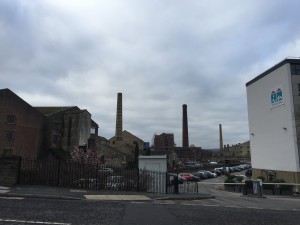
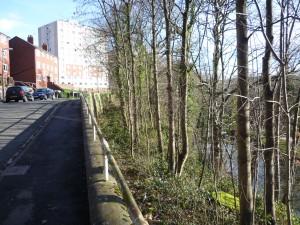
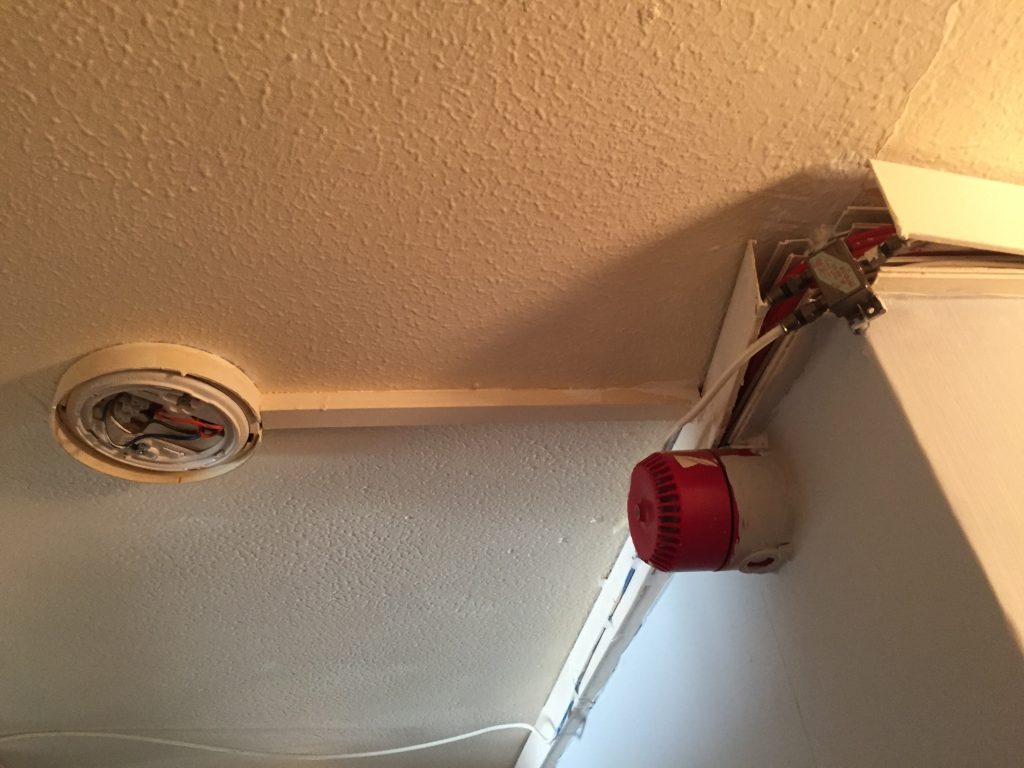
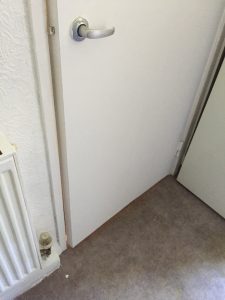

Really glad to see someone has started to listen to residents! Well done Jenni for being the communities representative.